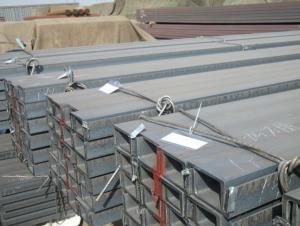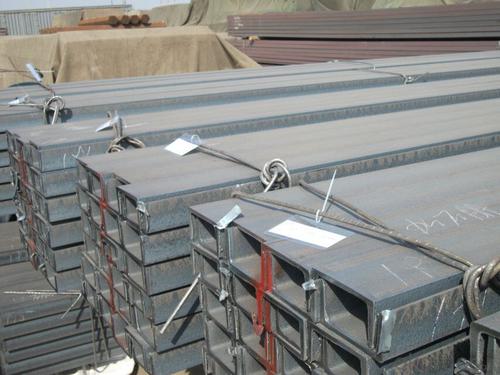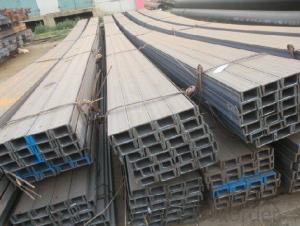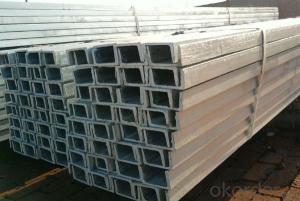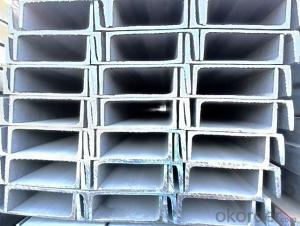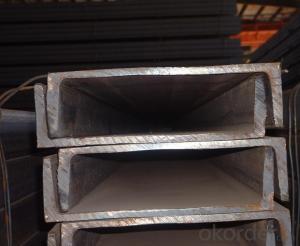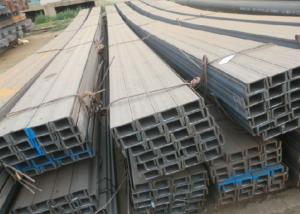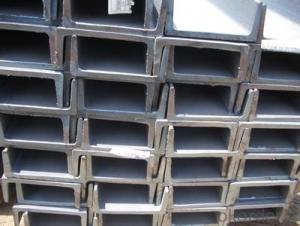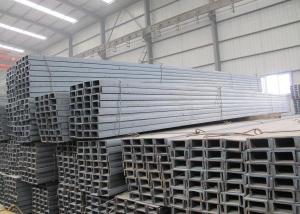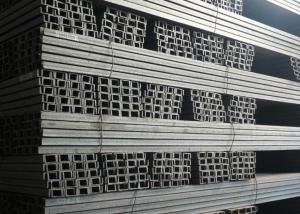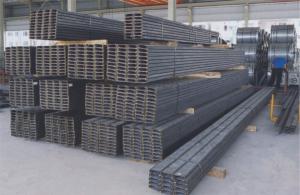U-Channels Hot Rolled with Highest Quality
- Loading Port:
- Tianjin
- Payment Terms:
- TT OR LC
- Min Order Qty:
- 25 m.t
- Supply Capability:
- 10000 m.t/month
OKorder Service Pledge
OKorder Financial Service
You Might Also Like
Specification
OKorder is offering high quality Hot Rolled U-Channels at great prices with worldwide shipping. Our supplier is a world-class manufacturer of steel, with our products utilized the world over. OKorder annually supplies products to European, North American ,Africa and Asian markets. We provide quotations within 24 hours of receiving an inquiry and guarantee competitive prices.
Product Applications:
Hot Rolled U-Channels are ideal for structural applications and are widely used in the construction of buildings and bridges, and the manufacturing, petrochemical, and transportation industries.
Product Advantages:
OKorder's U-Channels are durable, strong, and resist corrosion.
Main Product Features:
· Premium quality
· Prompt delivery & seaworthy packing (30 days after receiving deposit)
· Corrosion resistance
· Can be recycled and reused
· Mill test certification
· Professional Service
· Competitive pricing
Product Specifications:
Manufacture: Hot rolled
Grade: Q235/SS400
Certificates: ISO, SGS, BV, CIQ
Length: 6m – 12m, as per customer request
Packaging: Export packing, nude packing, bundle
JIS U CHANNEL | Standard | Sectional | Dimension |
| Mass: |
(mm) | (mm) | (mm) | (mm) | ||
50x25 | 50 | 25 | 3.0 | 6.00 | 2.37 |
75X40 | 75 | 40 | 3.8 | 7.00 | 5.30 |
75X40 | 75 | 40 | 4.0 | 7.00 | 5.60 |
75X40 | 75 | 40 | 4.5 | 7.00 | 5.85 |
75X40 | 75 | 40 | 5.0 | 7.00 | 6.92 |
100X50 | 100 | 50 | 3.8 | 6.00 | 7.30 |
100X50 | 100 | 50 | 4.2 | 6.00 | 8.03 |
100X50 | 100 | 50 | 4.5 | 7.50 | 8.97 |
100X50 | 100 | 50 | 5.0 | 7.50 | 9.36 |
125X65 | 125 | 65 | 5.2 | 6.80 | 11.66 |
125X65 | 125 | 65 | 5.3 | 6.80 | 12.17 |
125X65 | 125 | 65 | 5.5 | 8.00 | 12.91 |
125X65 | 125 | 65 | 6.0 | 8.00 | 13.40 |
150x75 | 150 | 75 | 5.5 | 7.30 | 14.66 |
150x75 | 150 | 75 | 5.7 | 10.00 | 16.71 |
150x75 | 150 | 75 | 6.0 | 10.00 | 17.90 |
150x75 | 150 | 75 | 6.5 | 10.00 | 18.60 |
150x75 | 150 | 75 | 6.5 | 10.00 | 24.00 |
200X80 | 200 | 80 | 7.5 | 11.00 | 24.60 |
FAQ:
Q1: Why buy Materials & Equipment from OKorder.com?
A1: All products are carefully selected from China's most reliable manufacturing enterprises. Through its ISO certifications, OKorder.com adheres to the highest standards and a commitment to supply chain safety and customer satisfaction.We can guarantee the quality!
Q2:What's your payment terms ?
A2: We can accecpt T/T,LC at sight and time LC.
Q3: Can you supply special size ?
A3: Yes, we can produce them as per buyers' requirement and all the standard are available for us .
Images
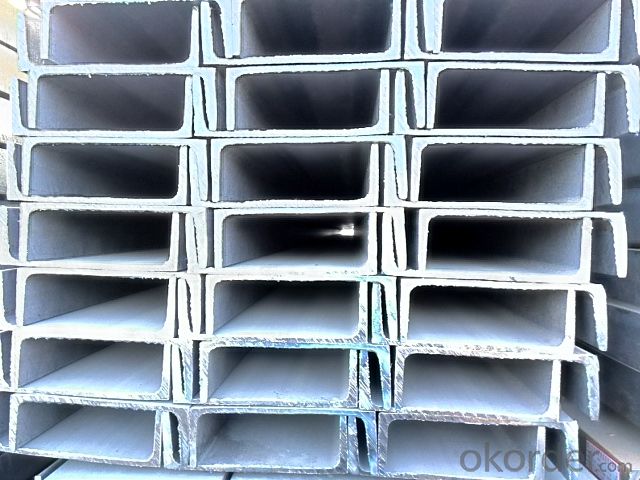
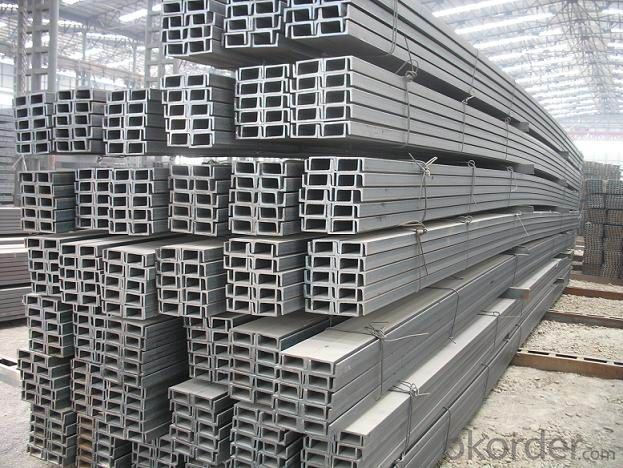
- Q: What are the recommended safety precautions when working with steel channels?
- When working with steel channels, it is important to follow recommended safety precautions to ensure a safe working environment. These precautions include: 1. Personal protective equipment (PPE): Always wear appropriate PPE such as safety glasses, steel-toed boots, gloves, and a hard hat. This will protect you from potential hazards like falling objects, sharp edges, and sparks. 2. Training: Receive proper training on how to handle steel channels, including how to lift and carry them safely, as they can be heavy and awkward to maneuver. Understanding the proper techniques will help prevent strains, sprains, or other injuries. 3. Inspection: Inspect steel channels before usage to identify any defects or damage. Defective channels can compromise safety, so it is crucial to ensure they are in good condition before installation or use. 4. Secure storage: Store steel channels in a designated area where they are secured properly to prevent them from falling or causing accidents. Proper storage also prevents damage to the channels and reduces the risk of potential injuries. 5. Handling and lifting: When lifting steel channels, always use mechanical lifting equipment or follow proper manual handling techniques. Avoid bending or twisting your body during lifting to avoid strains or back injuries. 6. Fire prevention: Steel channels can create sparks during fabrication or welding processes, so it is important to have fire prevention measures in place. Keep the work area clear of flammable materials, have fire extinguishers readily available, and follow established fire safety protocols. 7. Proper ventilation: Ensure that the work area is well-ventilated to minimize the risk of exposure to fumes or gases that may be released during welding or cutting processes. 8. Communication: Maintain effective communication with other workers in the area to prevent accidents caused by lack of coordination or awareness. Use hand signals, radios, or other appropriate means of communication to ensure everyone is aware of each other's actions. 9. Emergency preparedness: Be familiar with emergency procedures and have a first aid kit readily available. In the event of an accident or injury, knowing how to respond quickly and appropriately can help minimize the severity of the situation. By following these recommended safety precautions, you can significantly reduce the risk of accidents or injuries when working with steel channels. Prioritizing safety ensures a productive and secure work environment for everyone involved.
- Q: How do steel channels perform in terms of fire resistance?
- Steel channels, also known as steel sections or steel beams, generally have good fire resistance properties. The fire performance of steel channels is influenced by several factors, including the grade and thickness of the steel used, the arrangement of the channels, and the fire protection measures applied. Steel, being a non-combustible material, does not contribute to the spread of fire. However, it does lose its strength at high temperatures. The rate at which steel loses its load-bearing capacity in a fire depends on the temperature and duration of the fire exposure. To enhance the fire resistance of steel channels, various fire protection measures can be applied. The most common method is to encase the steel channels in fire-resistant materials such as concrete or gypsum boards. This encasement acts as a barrier, slowing down the transfer of heat to the steel and providing insulation, thus prolonging the time it takes for the steel to reach critical temperatures. Additionally, steel channels can be coated with intumescent coatings or fire-resistant paints. These coatings expand when exposed to high temperatures, forming a protective layer that insulates the steel and delays its temperature rise. Overall, steel channels, when properly protected, can offer significant fire resistance. However, it is essential to consider the specific fire safety requirements of a structure and consult with fire protection experts or follow applicable building codes and standards to ensure adequate fire resistance measures are implemented.
- Q: What are the different design considerations for steel channels in industrial buildings?
- Several important factors must be considered when designing steel channels for industrial buildings. Firstly, it is crucial to assess the load capacity of the channels. This involves calculating the maximum expected loads that the channels will need to support, such as the weight of machinery, equipment, or materials. It is necessary to design the channels with sufficient strength and stiffness to handle these loads without excessive deflection or deformation. Another significant consideration is the structural stability of the channels. The design must ensure that the channels are capable of resisting lateral forces, such as wind or seismic loads, without buckling or collapsing. This may require connecting or bracing the channels to other structural elements in order to provide the necessary stability. Additionally, the durability of the steel channels is a key concern. Industrial environments can be harsh, with exposure to moisture, chemicals, and other corrosive substances. Therefore, the channels must be designed to withstand these conditions and resist corrosion. This may involve the use of protective coatings or stainless steel materials. The ease of fabrication and installation is another factor that needs to be taken into account. The design should aim to minimize the complexity and time required for fabrication and construction. This can be achieved by using standard steel channel sizes and connections, as well as designing with efficient assembly methods in mind. Fire safety is also a crucial consideration in industrial buildings. Steel channels should be designed to have adequate fire resistance, either through the use of fireproof coatings or by incorporating fireproofing materials such as gypsum board. Finally, depending on the specific requirements of the industrial building, the aesthetic appearance of the steel channels may also be a consideration. While functionality and safety are of primary importance, the design may also need to consider the visual impact and architectural integration of the channels within the building. In conclusion, the design considerations for steel channels in industrial buildings include load capacity, structural stability, durability, ease of fabrication and installation, fire safety, and aesthetics. By carefully addressing these factors, the design can ensure the safe and efficient use of steel channels in industrial buildings.
- Q: What are the different steel channel profiles available?
- There are several different steel channel profiles available, including C channels, U channels, and J channels. These profiles have different shapes and sizes, allowing them to be used in various applications such as structural support, framing, and industrial machinery.
- Q: Q235's steel plate and channel steel were rusted in the rain. The corrosion is not too serious, but it looks obvious. Will this product be rejected? Is there a standard in this respect?Please answer professionals, thank you.
- Normally, they are not rejected unless the customer has made it clear that they want to prevent the rain.
- Q: What is the difference between channel steel and C steel?
- Channel steel is rail steel, relatively thick. C steel is rolled by iron plate
- Q: How do you calculate the load capacity of steel channels?
- The load capacity of steel channels can be calculated using the formula: Load capacity = Moment of inertia / (Section modulus x Distance from the neutral axis).
- Q: What are the standard lengths of steel channels?
- Different industries and manufacturers establish their own requirements and standards, leading to variations in the standard lengths of steel channels. However, there are commonly used standard lengths for steel channels, typically available in increments of 6 or 12 feet (1.83 or 3.66 meters). These standard lengths find widespread use in construction, manufacturing, and other sectors. Steel channels are commonly found in lengths of 20 feet (6.1 meters), 40 feet (12.2 meters), and 60 feet (18.3 meters), which are convenient for transportation, handling, and utilization in structural or fabrication projects. It is worth noting that although these are frequently encountered standard lengths, steel channels can also be custom-cut to meet the specific requirements of a given project. Additionally, regional or industry-specific standards may introduce variations in standard lengths. To obtain more precise information regarding the standard lengths of steel channels for a particular application, it is advisable to consult relevant industry standards, such as those established by organizations like the American Society for Testing and Materials (ASTM) or the American Institute of Steel Construction (AISC).
- Q: Are steel channels suitable for use in the construction of elevated storage systems?
- Yes, steel channels are suitable for use in the construction of elevated storage systems. Steel channels offer several advantages that make them a popular choice for such applications. Firstly, steel channels are known for their high strength and durability. They can withstand heavy loads and provide structural stability, making them ideal for supporting elevated storage systems. Additionally, steel channels have excellent resistance to corrosion, which is crucial in storage systems where exposure to moisture or harsh environmental conditions may occur. Furthermore, steel channels are versatile and can be easily fabricated into various shapes and sizes to meet specific design requirements. This allows for flexibility in constructing storage systems of different dimensions and configurations. Steel channels also offer ease of installation and can be efficiently connected using various methods such as welding or bolting. Another advantage of using steel channels in elevated storage systems is their cost-effectiveness. Steel is a relatively affordable material compared to alternatives like aluminum or composite materials. Additionally, steel channels require minimal maintenance over their lifespan, reducing long-term costs. Overall, the strength, durability, resistance to corrosion, versatility, and cost-effectiveness of steel channels make them highly suitable for use in the construction of elevated storage systems.
- Q: What are the common fabrication processes for steel channels?
- Steel channels can be fabricated using several common processes, including rolling, cutting, welding, and forming. Rolling is a primary method, where steel plates pass through rollers to shape them into desired channel profiles. This is often used for creating standard-sized channels with consistent dimensions. Cutting is also crucial, involving the slicing of steel plates or sections into required lengths. Various methods like shearing, sawing, or plasma cutting can be employed. Welding is utilized for joining different sections of steel channels, allowing for complex shapes or connections to other structural components. It involves heating the edges of the steel sections and fusing them together using techniques like arc or gas welding. Forming is a process that shapes steel channels into specific designs or configurations. This can be achieved through bending, rolling, or stamping. Bending is commonly used to create angles or curves, while rolling can produce tapered or custom-shaped channels. Stamping is often used to add features or patterns to the channel surface. In conclusion, these fabrication processes enable the production of a wide variety of sizes, shapes, and configurations for steel channels. As a result, they are versatile components widely used in industries such as construction, manufacturing, and infrastructure.
Send your message to us
U-Channels Hot Rolled with Highest Quality
- Loading Port:
- Tianjin
- Payment Terms:
- TT OR LC
- Min Order Qty:
- 25 m.t
- Supply Capability:
- 10000 m.t/month
OKorder Service Pledge
OKorder Financial Service
Similar products
Hot products
Hot Searches
Related keywords
